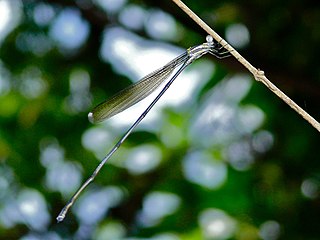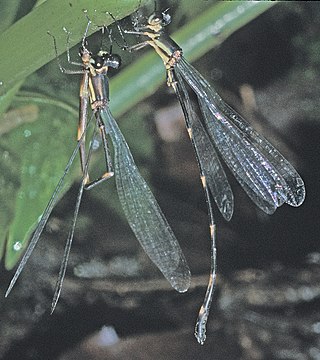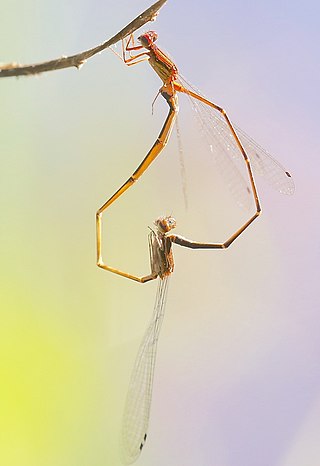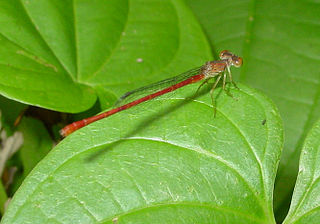| Micrathyria | |
|---|---|
 | |
| male M. hypodidyma, Colombia | |
| Scientific classification | |
| Domain: | Eukaryota |
| Kingdom: | Animalia |
| Phylum: | Arthropoda |
| Class: | Insecta |
| Order: | Odonata |
| Infraorder: | Anisoptera |
| Family: | Libellulidae |
| Subfamily: | Brachydiplacinae |
| Genus: | Micrathyria Kirby, 1889 |
| Type species | |
| Micrathyria didyma | |
Micrathyria is a Neotropical genus of dragonflies. They have bright green eyes and white faces. Most species have a markedly striped thorax. They are commonly known as Tropical Dashers. [1]
As of 2002, there were about 48 species. [2]
Species include: [3]
- Micrathyria aequalis (Hagen, 1861) - Spot-tailed Dasher [4]
- Micrathyria almeidai Santos, 1945
- Micrathyria artemis Ris, 1911 - Artemis Dasher [5]
- Micrathyria athenais Calvert, 1909
- Micrathyria atra (Martin, 1897) - Black Dasher [6]
- Micrathyria borgmeieri Santos, 1947
- Micrathyria caerulistyla Donnelly, 1992 - Blue-tipped Dasher [7]
- Micrathyria cambridgei Kirby, 1897
- Micrathyria catenata Calvert, 1909
- Micrathyria coropinae Geijskes, 1963
- Micrathyria debilis (Hagen, 1861)
- Micrathyria dictynna Ris, 1919
- Micrathyria dido Ris, 1911
- Micrathyria didyma (Selys in Sagra, 1857) - Three-striped Dasher [4]
- Micrathyria dissocians Calvert, 1906 - Caribbean Dasher [8]
- Micrathyria divergens Westfall, 1992
- Micrathyria dunklei Westfall, 1992
- Micrathyria duplicata Navás, 1922
- Micrathyria dythemoides Calvert, 1909
- Micrathyria eximia Kirby, 1897
- Micrathyria hagenii Kirby, 1890 - Thornbush Dasher [4]
- Micrathyria hesperis Ris, 1911
- Micrathyria hippolyte Ris, 1911 - Forest Dasher [9]
- Micrathyria hypodidyma Calvert, 1906
- Micrathyria iheringi Santos, 1946
- Micrathyria kleerekoperi Calvert, 1946
- Micrathyria laevigata Calvert, 1909
- Micrathyria longifasciata Calvert, 1909
- Micrathyria mengeri Ris, 1919
- Micrathyria occipita Westfall, 1992
- Micrathyria ocellata Martin, 1897
- Micrathyria paruensis Geijskes, 1963
- Micrathyria pirassunungae Santos, 1953
- Micrathyria pseudeximia Westfall, 1992
- Micrathyria pseudhypodidyma Costa, Lourenço & Viera, 2002 [2]
- Micrathyria ringueleti Rodrigues, 1988
- Micrathyria romani Sjöstedt, 1918
- Micrathyria schumanni Calvert, 1906
- Micrathyria spinifera Calvert, 1909
- Micrathyria spuria (Selys, 1900)
- Micrathyria stawiarskii Santos, 1953
- Micrathyria surinamensis Geijskes, 1963
- Micrathyria sympriona Tennessen, 2000
- Micrathyria tibialis Kirby, 1897 - Pale-footed Dasher [10]
- Micrathyria ungulata Förster, 1907
- Micrathyria venezuelae De Marmels, 1989




















